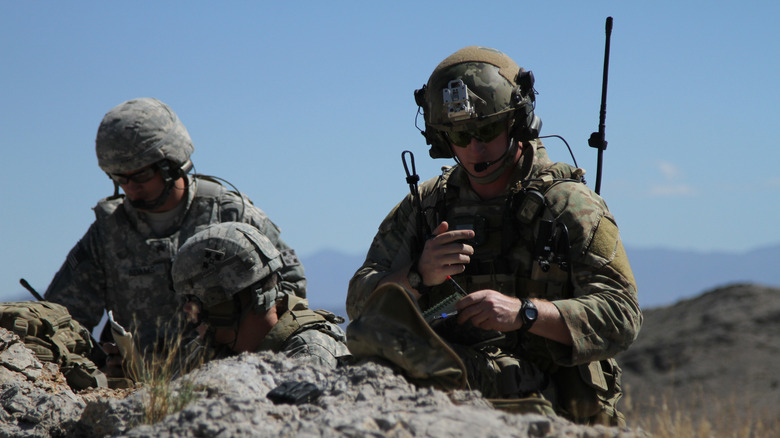What Exactly Is SpaceX's Starshield (And Why Does The US Space Force Need It)?
As one of the most reliable and efficient space launch providers in the entire industry, it wasn't surprising that SpaceX has been entrusted with defense contracts left and right, from spy orbiters to next-generation GPS satellites. However, the U.S. Space Force's recently unveiled Commercial Space Strategy is seeking to deepen the tie between the U.S. national defense apparatus and the commercial space sector.
Within the report, the service heavily emphasizes satellite communication (SATCOM) as one of the core pillars of its strategy, "The availability of global SATCOM is critical to the posture and mission effectiveness of modern warfighting for the United States and its allies." This isn't a conclusion that's been borne over the top of an office's desk. Ukraine has been fielding SpaceX's Starlink satellite internet terminals to provide a host of battlefield functions for its troops in its battle against Russia, ranging from command and control (C2) to recon and intelligence gathering. Starlink was such a strategic advantage for Ukraine that these dish-shaped Internet terminals, alongside generators, were given special tax-exempt status by the Ukrainian government for importing into the embattled country.
As such, it's not at all surprising that the Space Force is interested in "conscripting" Starlink for national defense. But, as a civilian-centric system, Starlink is vulnerable to jamming and its users can be geolocated, making it a less-than-ideal option for battlefield communication. SpaceX's solution: a militarized version of Starlink for defense customers only, aptly named "Starshield."
Starshield is the one-stop-shop for all government services
According to SpaceX's public page about Starshield, the program aims to use "SpaceX's Starlink technology and launch capability to support national security efforts." SpaceX's workhorse Falcon 9 rocket has been reliably launching payloads for government agencies for years, so the launch service isn't at all surprising.
What's interesting is the satellite payload. Unlike Starlink, the Starshield satellites have "high-assurance cryptographic capability." In other words, Starshield can broadcast end-to-end encrypted, jam-safe communication, similar to those seen on existing SATCOM infrastructure like the Advanced Extremely High Frequency (AEHF) and the Wideband Global SATCOM (WGS) systems. The satellites also have laser communication equipment, greatly speeding up transmission speed. Beyond SATCOM, the website also noted that Starshield can provide "Earth observation" ability using "sensing payloads." This obviously means the Starshield network also includes spy satellites — the same ones that Reuters has recently reported that SpaceX and the National Reconnaissance Office (NRO) are building for $1.8 billion.
Starshield also transforms SpaceX into a "satellite factory" for the U.S. The company has noted that it also can "build satellite buses to support the most demanding customer payload missions". Presumably, SpaceX may have built a customizable satellite bus that can be refitted, Lego-style, with different sensors and payloads to meet the specific needs of government customers, whether it's secure communications or intelligence gathering. This dual role as a satellite builder and launch provider positions SpaceX uniquely in the industry as a one-stop-shop for all governmental space-based needs.
The Impact of Starshield on the U.S Military Going Forward
The civilian Starlink has already proven to be an invaluable asset for any military that possesses it. As said, Starlink was the force multiplier for the outnumbered-and-outgunned Armed Forces of Ukraine at the beginning of the full-scale invasion. However, being made in civilian specs, its signal can be jammed and intercepted. Plus, the service itself can also be exploited by the opposing force, with recent news indicating that the Russians have also started using Starlink, too.
With Starshield, the U.S. military can access vital high-speed communication services provided by SpaceX's satellite constellation with none of these concerns. Additionally, the service fits right into the futuristic Joint All Domain Command and Control (JADC2) doctrine of the Department of Defense (DoD), which aims to interconnect all the sensors, fighters, and platforms in use by the branches within the U.S. military (and eventually allies) into a "network-of-network" governed by artificial intelligence (AI). Seamless integration and quicker coordination in combat operations are just one of the many benefits that this doctrine — if achieved — can provide.
However, JADC2 hinges on the Pentagon's ability to facilitate accurate, near real-time combat data from headquarters to warfighters. It's a massive technical hurdle that Starlink/Starshield has the potential to solve for good. With a dozen Starshield prototypes already launched since 2020 and more in the pipeline, it's clear that whichever direction the U.S. military is taking in space in the future, SpaceX will be along for the ride.


